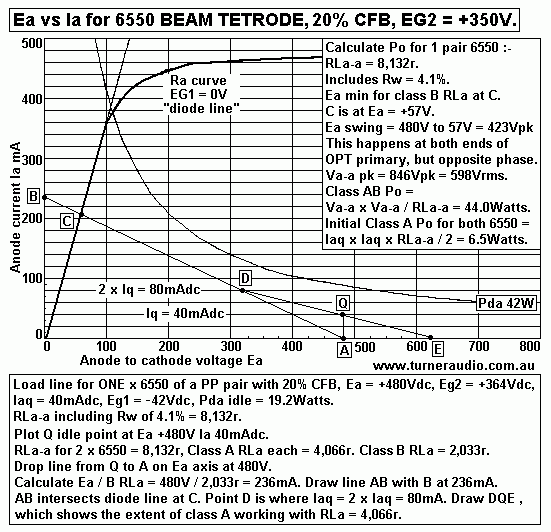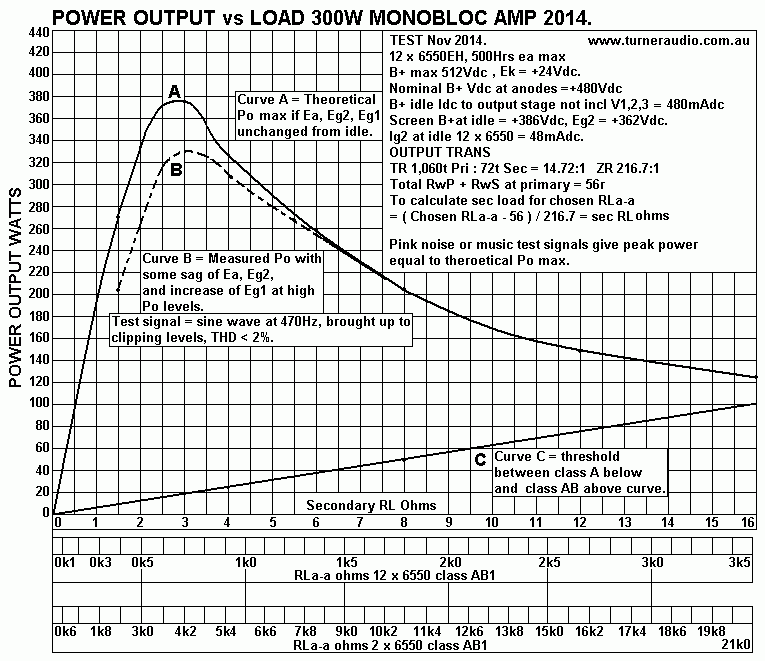


| Sec RL for 2 x 6550 |
P:S OPT ZR = 1,300 :1 ZR x sec RL |
RLa-a = ZR x RL
+ RwP+S +336r. |
Total Rw Loss% |
Class AB B RLa for 1 x 6550 = 0.25 x RLa-a |
load line B RLa Intersect diode line = Ea min |
Ea pk swing = Ea - Ea min = Va pk |
Va-a across primary Vrms |
Anode Po RLa-a for 2 x 6550 |
Sec AB1 Po less Rw % loss |
Sec pure class A Po |
Sec AB1 Po 12 x 6550 |
| 1r5 |
1,950r |
2,286r | 14.6% |
571r |
235V |
245Vpk |
346V |
52.4W |
44.7W |
1.6W |
268W |
| 2r0 |
433r |
2,934r | 11.4% |
733r |
175V |
305V |
431V |
63.3W |
51.9W |
2.1W |
311W |
| 3r0 |
650r |
4,236r | 7.9% |
1,059r |
100V |
380V |
537V |
68.1W |
62.7W |
13.2W |
376W |
| 4r0 |
866r |
5,532r | 6.1% |
1,389r |
80V |
400V |
565V |
57.7W |
54.2W |
4.2W |
325W |
| 6r0 |
1,300r |
8,136r | 4.1% |
2034r |
57V |
423V |
598V |
43.9W |
42.1W |
6.5W |
263W |
| 8r0 |
1,733r |
10,734r | 3.1% |
2,683r |
45V |
435V |
615V |
35.2W |
34.1W |
8.3W |
205W |
| 12r0 |
2,600r |
15,602r | 2.1% |
3,900r |
30V |
450V |
636V |
25.9W |
25.4W |
12.5W |
155W |
| 16r0 |
3,467r |
21,138r | 1.6% |
5285r |
13V |
467V |
660V |
20.6W |
20.2W |
16.6W |
121W |

| Primary turns 1,060t RLa-a Ohms |
Sec RL Ohms 9 // 48t |
Sec RL Ohms 6 // 72t |
Sec RL Ohms 4 // 96t |
Sec RL Ohms 3 // 144t |
Sec RL Ohms 2 // 216t |
Sec RL Ohms 1 x 432t |
Class A max Watts |
Class AB max Watts |
| 800r |
1.64 |
3.69 |
6.56 |
14.76 |
33.22 |
132.87 |
21 |
322 |
| 1k2 |
2.46 |
5.53 |
9.84 |
22.12 |
49.74 |
199.08 |
32 |
270 |
| 1k6 |
3.28 |
7.38 |
13.12 |
29.52 |
66.43 |
265.75 |
45 |
226 |
| 2k4 |
4.92 |
11.07 |
19.68 |
44.28 |
99.48 |
398.62 |
68 |
160 |
| 3k2 |
6.56 |
14.76 |
26.24 |
59.04 |
132.86 |
531.50 |
91 |
135 |
| 4k8 |
9.88 |
22.14 |
39.36 | 88.56 |
198.96 |
797.24 |
92 |
92 |
| 6k4 |
13.12 |
29.52 |
52.48 |
118.08 |
265.72 |
1,063.00 |
68 |
68 |
| Watts per channel |
Speaker Z 4r0 Nominal |
Vrms |
Speaker Z 6r0 Nominal |
Vrms |
Speaker Z 8r0 Nominal |
Vrms |
Speaker Z 12r0+ |
Vrms |
|||
| 50W home |
9 // 48t |
14.1 |
9 // 48t | 17.3 |
6 // 72t |
20.0 |
6 // 72t | 24.5 |
|||
| 100W home |
9 // 48t |
20.0 |
9 // 48t |
24.5 |
6 // 72t |
28.3 |
6 // 72t |
34.6 |
|||
| 150W home - pro |
9 // 48t |
24.4 |
6 // 72t |
30.0 |
6 // 72t |
34.6 |
6 // 72 |
42.4 |
|||
| 300W pro |
9 // 72t |
34.6 |
6 // 96t |
42.4 |
4 // 96t |
49.0 |
3 // 120t |
60.0 |